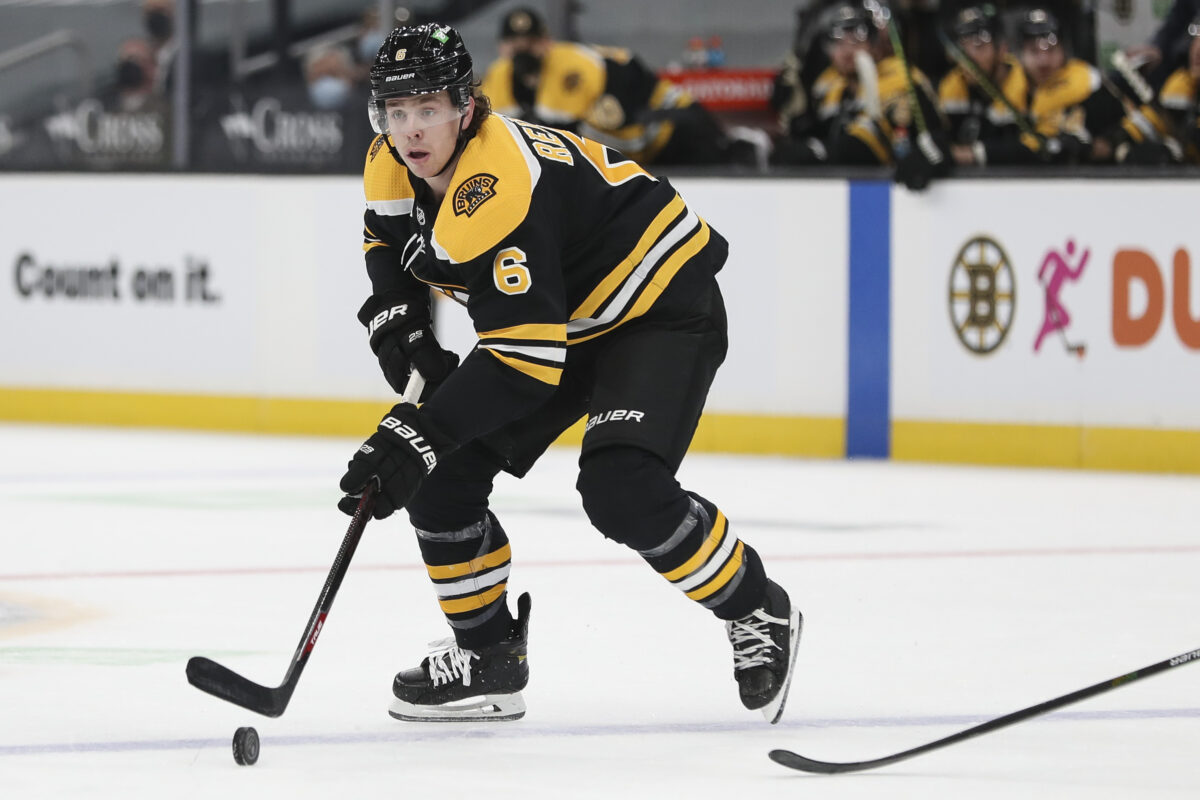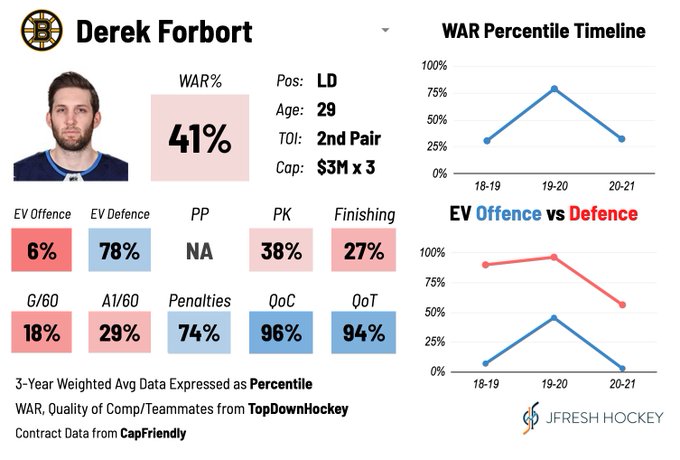While the 2021-22 NHL season approaches, the Boston Bruins have spent their busy offseason looking to improve their roster. One area of special interest following their second-round exit last season has been the defense, a young group that has seen some significant turnover in the past couple of years and been a recent source of criticism. Inexperience and a lack of physicality are the main complaints regarding the depth and capability of the Bruins’ blue line, particularly on the left side.
We’ve seen general manager Don Sweeney address these needs with two moves: Brandon Carlo’s defensive partner, Mike Reilly, was re-signed to a 3-year contract worth $9 million, while free-agent defenseman and former Winnipeg Jets veteran Derek Forbort was signed to a contract of the same length and value. Now, following the Seattle Kraken’s selection of Jeremy Lauzon in the Expansion Draft, the difference between this year’s defensive group and last year’s is the addition of Forbort in place of Lauzon.

Still, many questions are lingering on how this defensive core will perform come October, and it remains to be seen if all of the issues from last season have been solved. If the Bruins want to make another run at the Stanley Cup with the veteran core they have left, they will need to answer these questions regarding their blue line.
Is Physicality Still an Issue?
Bruins fans have often clamored about the lack of size and physicality on the team. This may hold some truth, considering the Bruins were the second-shortest team in the NHL in 2020-21. The defense, in particular, has gotten the brunt of the criticism following a somewhat lackluster performance in the playoffs; Reilly was accused of avoiding hits, while Grzelcyk played an uncharacteristically poor game when facing elimination against the New York Islanders. It certainly didn’t help that the biggest guy on the blue line, Brandon Carlo, was plagued with injuries that took him out of the second-round series. At some points, it seemed like the defense’s interim hit man was the 5-foot-11 Connor Clifton.

Forbort, who is 6-foot-4 and plays a physical game, is clearly Don Sweeney’s solution to the problem. But while he and Clifton might make the third pairing a menacing presence on the ice, there are still the second and first pairings to think about. Grzelcyk will be in a full-time role next to Charlie McAvoy against the toughest competition in the league, and it raises questions about how a small player like him will stay healthy and perform at his best. However, his skills and talents as a defenseman are more than enough to qualify him for the role, and taking on top-pairing minutes in an 82-game season will give him a chance to finally establish himself as the man for the job.
Meanwhile, the second pairing will be an unknown until Carlo and Reilly can play significant minutes with each other. Reilly’s role on the blue line is to be an offense driver that complements Carlo’s stay-at-home defensive style, which means physicality will not be a big part of his game. Still, it would be reassuring to see him step up a bit more in that department to ensure that Carlo, who has a significant concussion history, does not have to shoulder that burden as much in their ice-time together.
Is Forbort Enough?
The signing of Forbort was Sweeney’s sole move to upgrade the blue line from last season’s, and the team will have to rely on him to meet his expectations to succeed. However, the fact that he will be taking on only a third-pairing role doesn’t quite scream “difference-maker,” so what does he add to this defensive group that significantly improves them?
Forbort’s defensive metrics are notable, and the decline he showed between 2019-20 and 2020-21 may simply be attributed to a down year on a Jets team that has struggled defensively. Furthermore, he was placed in a second-pairing role that pitted him against some of the toughest competition while still managing to put up respectable numbers – showing a defensive soundness that has been sorely needed on the bottom pairing. His offensive numbers leave something to be desired, but it’s reasonable to predict that his stay-at-home defensive nature will allow Clifton to flourish more on the offensive side, as he once did before.
However, even with the third pairing stabilized and sound, the question remains: is that enough to get this group running smoothly again? Many fans were expecting Sweeney to get a top-4 defenseman in free agency or through a trade, and it’s hard to imagine a simple bottom-pairing fix being the sole solution to their defensive concerns. By leaving the top two pairings alone this offseason, Sweeney may be taking another gamble on this defense, similar to last season.
How Will They Manage Injuries?
The Bruins’ defense’s final concern is their depth and sustainability: what will they do when the injuries hit, and how will it affect their performance? Much of this group’s effectiveness relies on the players’ specialization to their roles, which could lead to some problems if an injury forces some of them to slide around in the lineup.

At the moment, it appears that the Bruins simply don’t have a lot of options to work with if one of their defensemen is out for a significant period of time. Their depth pieces consist of Jakub Zboril, Urho Vaakanainen, Jack Ahcan, and potentially John Moore, none of which have a proven track record of long-term reliability. This means that even one injury – let alone multiple – will introduce a major wild card to their mix.
Latest Bruins Content:
It’s almost a certainty that the Bruins’ defense will face at least one injury, so it is crucial that they aren’t caught with their pants down when it happens. The team may have to address their depth issue in the coming months to prevent another situation where their defense closer resembles an AHL team, or at least avoid any undoing of the improvements they have made this offseason.
Sweeney May Not Be Done
It is still relatively early in the offseason, and there is always the chance that Sweeney signs another defenseman or makes a trade. With only a little over $1 million in cap space, they likely can’t afford any big-name free agents or trade targets with big contracts, so the search would have to be for more depth pieces. Still, this kind of move may be necessary for the sustainability of their defense.
If not, Sweeney will be rolling the dice on whether this defensive group has what it takes to go the distance. Being just as good as last year’s group will not be good enough; the team won’t succeed without a strong blue line, especially now that the goaltending situation is up in the air. In the meantime, they must spend the rest of their offseason considering their lingering defensive concerns and determine if any further changes are warranted.

Bentley University class of ’22. Bruins fan from Massachusetts with a love of all things hockey. Started playing in high school and never looked back.

